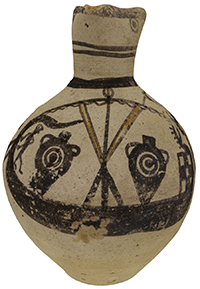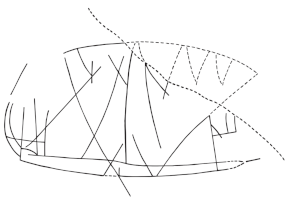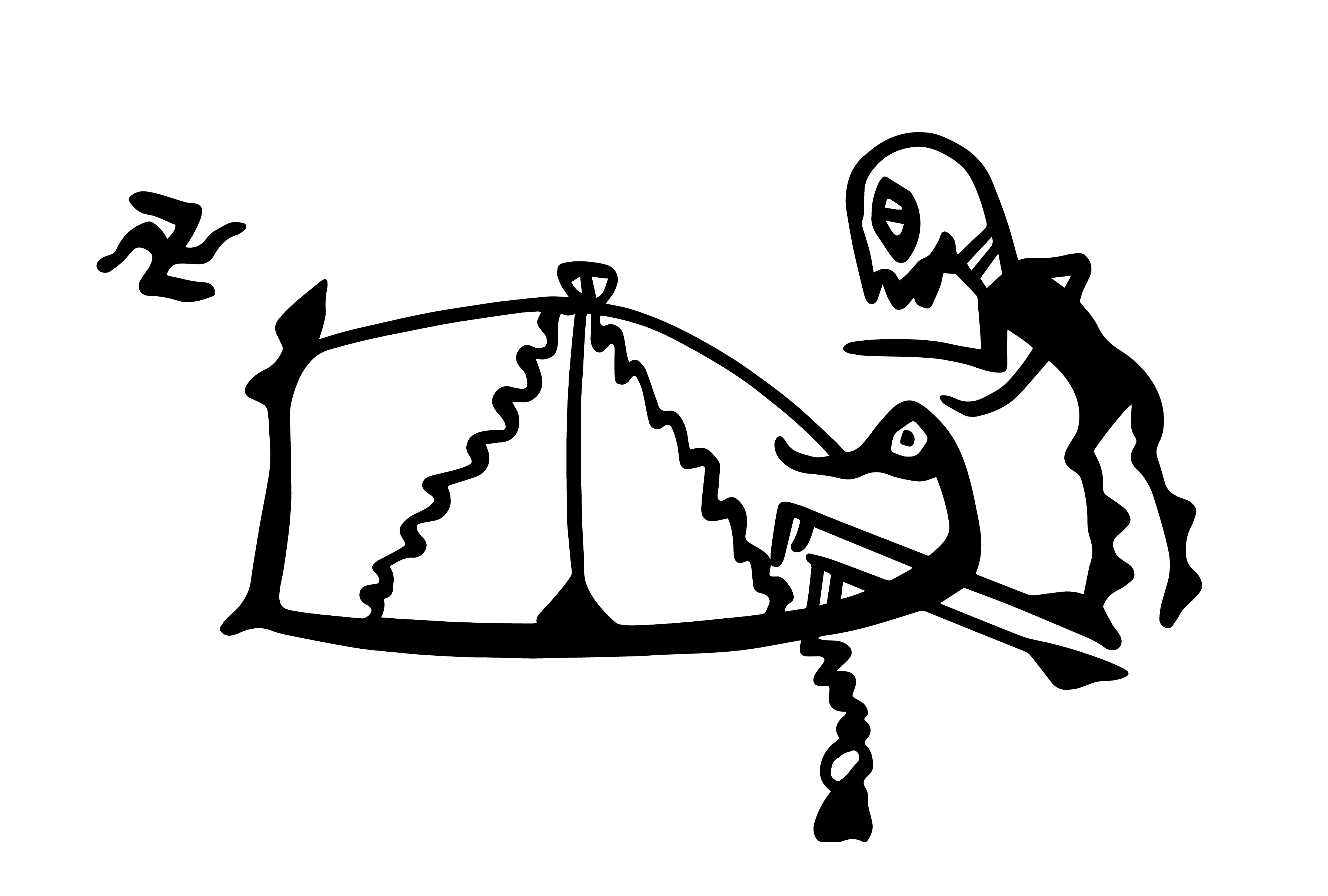Single-levelled ship to the left. The hull is low and slightly curved. High vertical stempost with a short bow projection that points downwards. High curving stempost ending in a very naturalistic bird-headed device facing inboard, complete with an eye and a well outlined beak. There are two steering oars, each with a loom and triangular shaped oar blades. The mast is amidships, with a mast-head comprised of two sheaves much like the one on the contemporaneous ship on the British Museum jug, except that it is not perfectly circular. The yard is rendered as a slightly downwards curving line raised to the top of the mast, its ends touching the top of the stem and sternpost. The sail is presumably furled but is not depicted. A small triangle at the base of the mast must be the mast-step system which secured it in place. A triangular anchor is shown being dropped at the stern. It is connected to a loop which itself is attached to a hawser painted as a zig-zag that runs on either side of the mast forming a triangle, and passes through a sheave in the mast cap. An oversized figure appears to be observing the ship from above near the stern. There is a swastika in the left corner close to the tip of the stempost.
Galley with deployed anchor
C6
c. 750-600 B.C. (Cypro-Archaic I)
Cyprus, further provenance unknown
H: 14 cm
White Painted IV jug
Nicosia Archaeological Museum 1947/I-16/1
Basch 1987: 258, no. 563; Frost 1982: 161-63, fig. 1.2; Karageorghis and Des Gagniers 1974: 123, no. XI.2; Wachsmann 1998: 183, fig. 8.41a; Westerberg 1983: 44, no. 54, fig. 54
The bow projection is in no way a functional ram for a number of reasons. It is short and flimsy, it is not integrated to the stempost, and does not form a straight continuation of the keel line. It should therefore we read as a cutwater similar to those observed on LBA Aegean galleys and not as an offensive weapon.
Frost remarks that the detail of the cable not being tied directly to the anchor's piercing but rather through the use of an intermediary hoop is very realistic: "The purpose of the loop was to minimize the surface movement of the waves that would otherwise have been transmitted directly through the cable to the head of the anchor, causing it to rock up and down so that it would loose its grip on the bottom and eventually drag."(Frost 1982: 162). The positioning of the anchor being dropped at the stern rather than the prow is peculiar however. She proposes that this must be a sacred anchor that would be used only in an emergency when all else has failed. Although the attestations of this ritual are much later, she singles out the votive use of anchors in a LBA temple context at Kition.
Other possible elements which might indicate that a crisis is being depicted include the ominous oversized figure looming over the ship which could be read as a deity, as well as the swastika, which is a symbol that is prominently depicted on the gruesome shipwreck scene from Pithekoussai. Finally, Frost hypothesizes that the zig-zag rope which is reminiscent of waves or lightning could be a way of indicating the effects of both on the ship - the storm having made the rigging useless.
Basch, L. 1987. Le musée imaginaire de la marine antique. Athens: Institut Hellénique pour la preservation de la tradition nautique.
Frost, H. 1982. “On a sacred Cypriote Anchor,” in J. Starcky and F. Hours (eds.) Archéologie au Levant: recueil à la mémoire de Roger Saidah. Lyon: Maison de l'Orient, pp. 161-66.
Karageorghis, V. and J. Des Gagniers. 1974. La céramique chypriote de style figuré. Âge du Fer (1050-500 av. J.-C.). Roma: Istituto per gli Studi Micenei ed Egeo-Anatolici.
Wachsmann, S. 1998. Seagoing Ships & Seamanship in the Bronze Age Levant. College Station, TX: Texas A&M University Press.
Westerberg, K. 1983. Cypriote Ships from the Bronze Age to c. 500 B.C. (SIMA, Pocket-books, 22). Göteborg: P. Åströms förlag.









